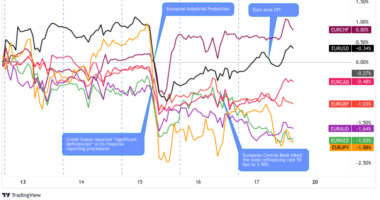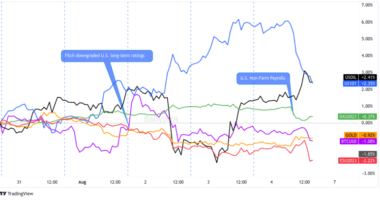The euro (EUR) climbed back above parity with the U.S. dollar today!
The last time that the EUR/USD was at 1.0000 was over a month ago, but after five days straight of gains, the euro is now, once again, stronger than the dollar! ?
Not only did EUR/USD manage to break above 1.000, but it also convincingly broke through its 50 SMA (pink line), which had been acting as dynamic resistance since March.
Then when you consider the fact that a higher low was made 2 weeks ago, you start to wonder…
Could this be the start of an uptrend? ?

One reason for the recent euro strength is due to market expectations of a large interest rate hike and a hawkish outlook by the European Central Bank (ECB) tomorrow.
But probably the biggest reason has to do with the U.S. dollar broadly weakening across all major currencies after several negative U.S. economic data reports were released since the start of the week.
These negative economic data, such as weaker house price growth and consumer confidence, helped to increase speculation that the Federal Reserve (“Fed”) will become less hawkish and slow its interest rate hikes.
Not familiar with interest rates? Read our lesson on Why Interest Rates Matters to Forex Traders.
In an attempt to bring stubbornly high inflation under control, the Fed had been hiking rates aggressively, causing the U.S. dollar to soar this year. ?
While the Fed is still widely expected to hike by another 75 basis points (0.75%) in November, market expectations are growing for a less aggressive hike in December, where they now might only hike by 50 basis points (0.50%) versus the previously expected 75 basis points increase.
That’s what the market thinks, but what does JPow think?

I’m with JPow here.
Even IF the market is right and they do hike by “only” 50 basis points in December, what’s really important is when they’ll actually stop hiking altogether and what that specific interest rate will be (known as the “terminal rate“).
For the Fed, it’s all about inflation. And inflation remains stubbornly HIGH.
While there are signs showing it’s possible it’s peaked, there’s been no meaningful drop yet.
And until there’s a meaningful drop, the Fed will not signal a lower terminal rate.
This means that the Fed’s plan to continue hiking interest rates for the foreseeable future remains.
And until the Fed does change its plan, unless other central banks are willing to maintain (or increase) their pace of interest rate hikes relative to the Fed, then the U.S. dollar should remain buoyant.

In other news, due to the U.S. dollar weakness, guess what else has been going up?
After big rallies, psychological resistance levels were broken with bitcoin (BTC) now back up above $20,000 and ether (ETH) back up above $1,500.
If you’re new to cryptocurrencies, check out our School of Crypto. Our online crypto course is made for beginners to help them learn how to navigate the crypto market.
Let’s review what else happened in the FX market today…
Currency Market Movers
Which currency pairs gained the most today?
As shown by our FX Market Movers page, AUD/USD was the leader of the pack, gaining 1.62% or 103 pips. ?
Which currency pairs lost the most today?
USD/JPY.was the biggest loser, falling 1.10% or 162 pips! ?
This currency pair continues to weaken so it looks like the intervention that I talked about seems to be working.
The Bank of Japan (BoJ) meets tomorrow so be prepared for some potential volatility.
Unlike other major central banks that have been aggressively hiking interest rates in an attempt to contain inflation, the BoJ is an outlier keeping its interest rate unchanged and sticking with its negative interest rate policy (NIRP) and yield curve control (YCC).
Currency Strength
What was the overall strength or weakness of individual major currencies today?
Based on the Currency Strength Meter on MarketMilk™, AUD was the strongest currency. ?
Australian inflation rose to a 32-year high last quarter. The annual consumer price index shot up to 7.3%, from 6.1%, the highest since 1990!
This higher-than-expected inflation data caused traders to buy AUD betting that the RBA would reverse its dovish stand and return to more aggressive rate hikes.
The U.S. dollar (USD)) was the weakest currency.

Currency Short-Term Trends
When it comes to short-term trend strength, the British pound (GBP) and euro (EUR) show the most bullish strength. While the AUD and NZD are bullish as well.
The U.S. dollar (USD), Canadian dollar (CAD), and Swiss franc (CHF) are the most bearish trend strength.
Currency Volatility
Which currency was the most volatile today?
Based on our Currency Volatility Meter, it’s the U.S. dollar (USD).
Which currency pair was the most volatile today?
Given that the USD was the most volatile currency, it has to be a USD pair. But which one?
AUD/USD. From its high to low, it moved over 2.18% or over 138 pips!
Are you bullish or bearish on EUR/USD?
Is EUR/USD a buy or sell? Here’s what MarketMilk™ indicators say…














